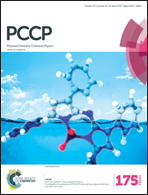Coupled metal partitioning dynamics and toxicodynamics at biointerfaces: a theory beyond the biotic ligand model framework†
Abstract
A mechanistic understanding of the processes governing metal toxicity to microorganisms (bacteria, algae) calls for an adequate formulation of metal partitioning at biointerfaces during cell exposure. This includes the account of metal transport dynamics from bulk solution to biomembrane and the kinetics of metal internalisation, both potentially controlling the intracellular and surface metal fractions that originate cell growth inhibition. A theoretical rationale is developed here for such coupled toxicodynamics and interfacial metal partitioning dynamics under non-complexing medium conditions with integration of the defining cell electrostatic properties. The formalism explicitly considers intertwined metal adsorption at the biointerface, intracellular metal excretion, cell growth and metal depletion from bulk solution. The theory is derived under relevant steady-state metal transport conditions on the basis of coupled Nernst–Planck equation and continuous logistic equation modified to include metal-induced cell growth inhibition and cell size changes. Computational examples are discussed to identify limitations of the classical Biotic Ligand Model (BLM) in evaluating metal toxicity over time. In particular, BLM is shown to severely underestimate metal toxicity depending on cell exposure time, metal internalisation kinetics, cell surface electrostatics and initial cell density. Analytical expressions are provided for the interfacial metal concentration profiles in the limit where cell-growth is completely inhibited. A rigorous relationship between time-dependent cell density and metal concentrations at the biosurface and in bulk solution is further provided, which unifies previous equations formulated by Best and Duval under constant cell density and cell size conditions. The theory is sufficiently flexible to adapt to toxicity scenarios with involved cell survival-death processes.


 Please wait while we load your content...
Please wait while we load your content...